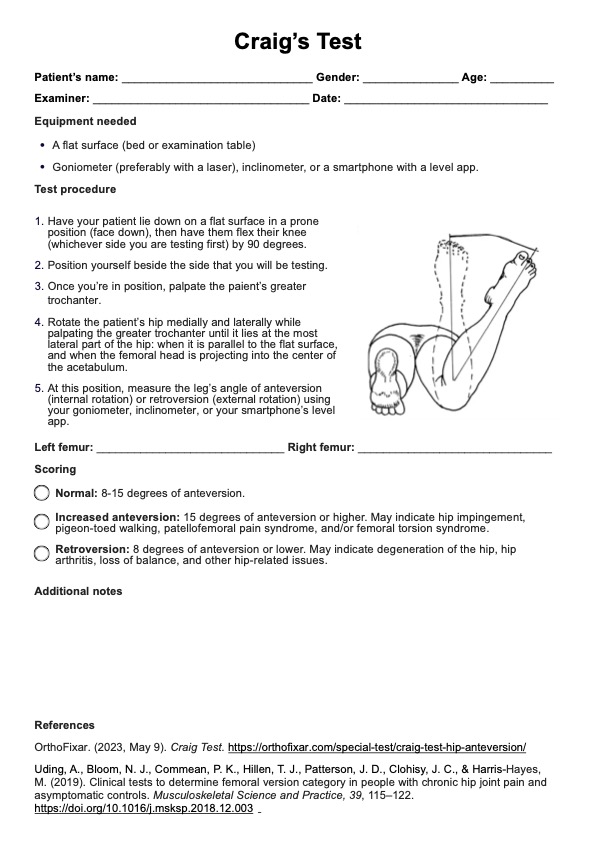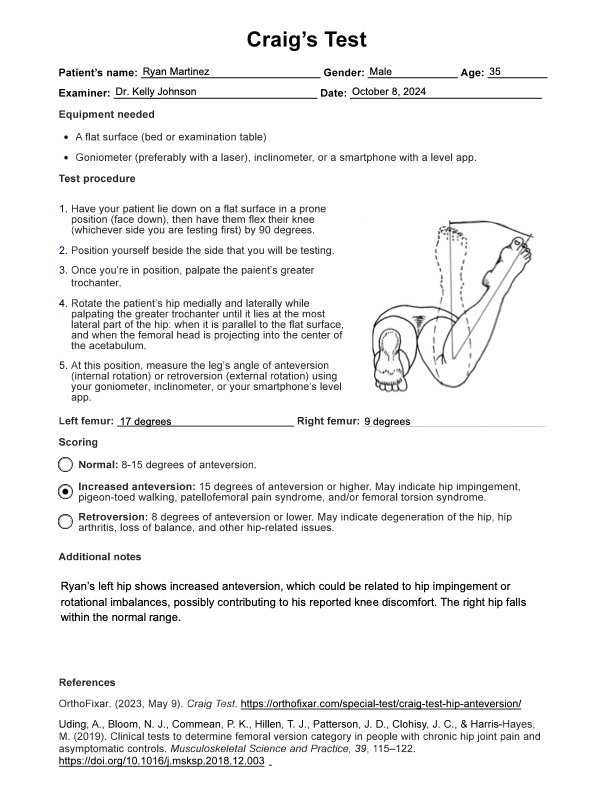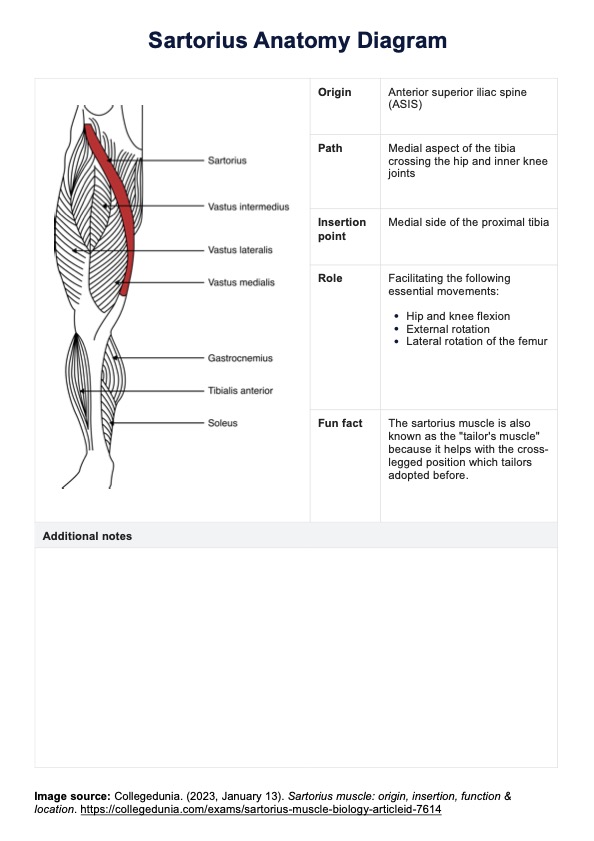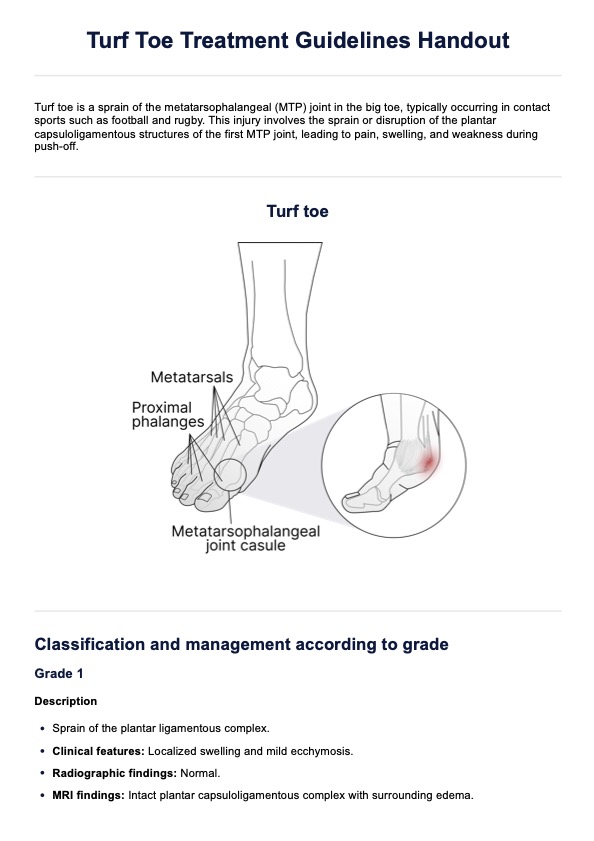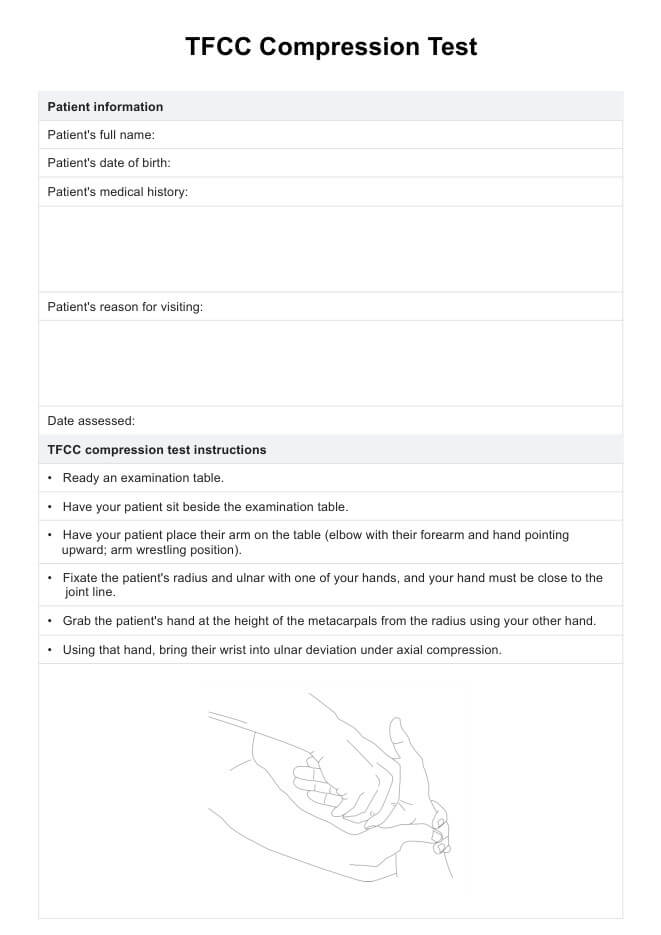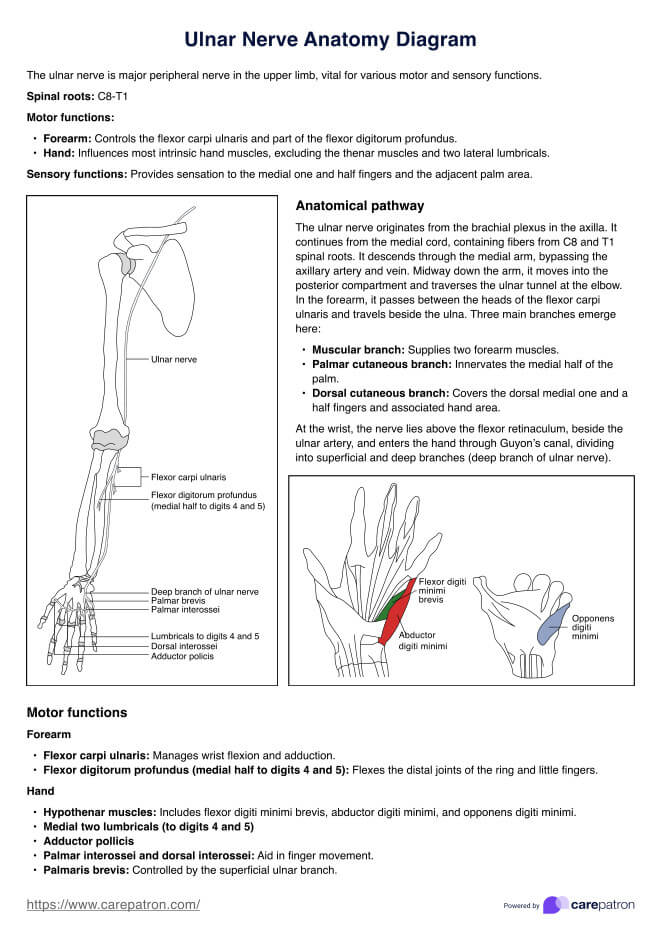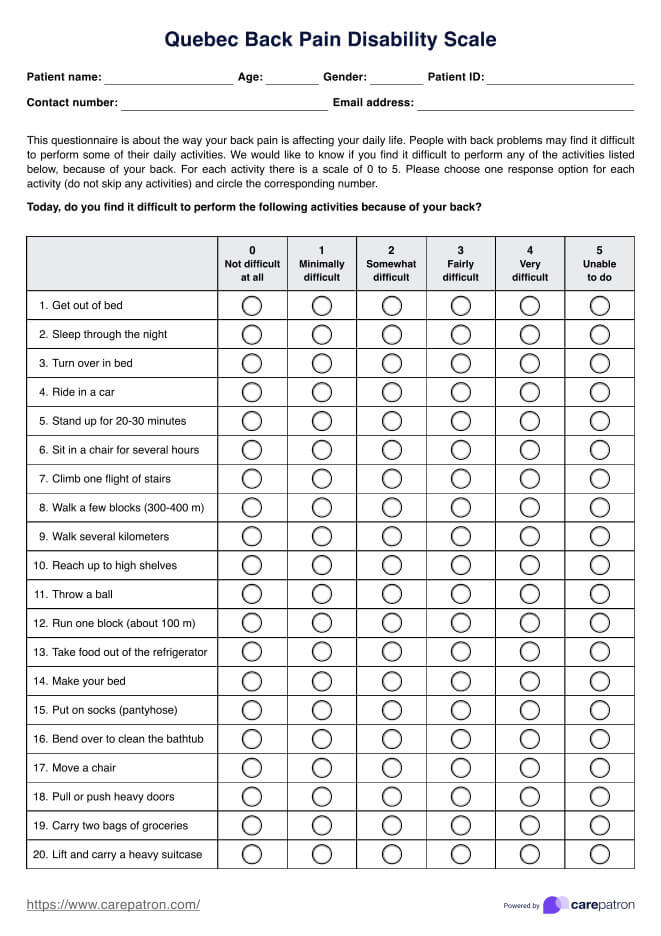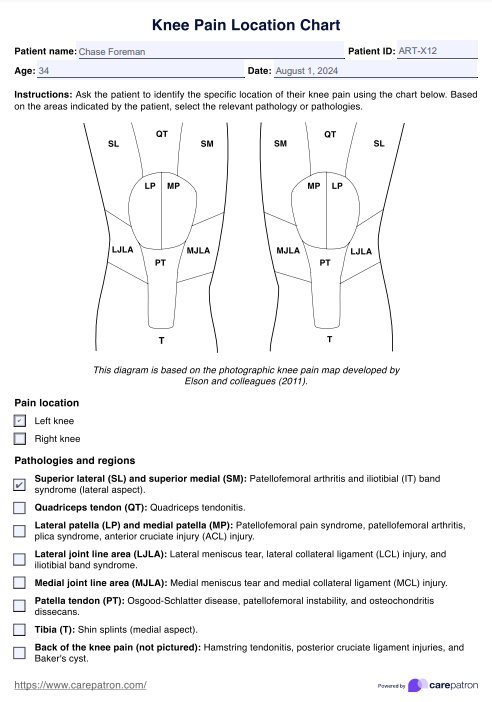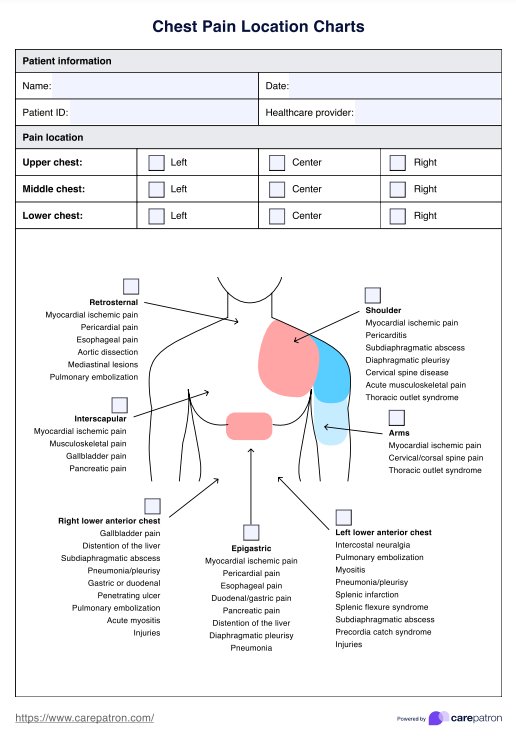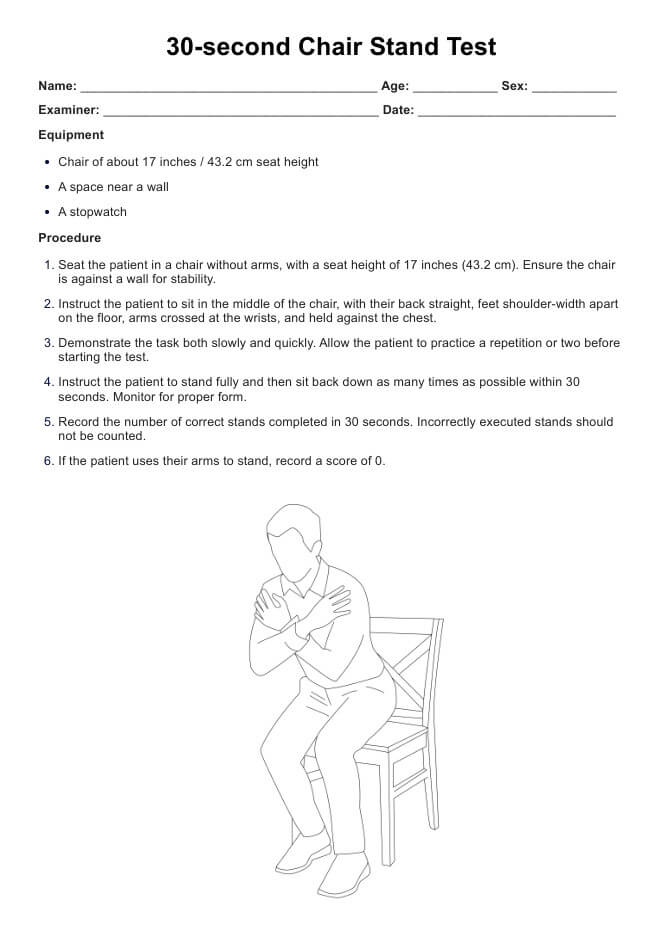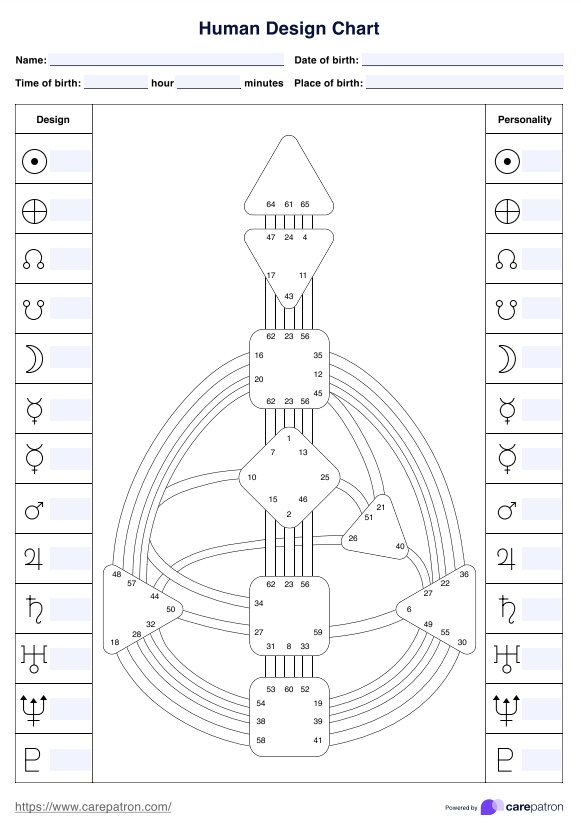Craig’s Test
Efficiently and consistently assess femoral anteversion and identify hip issues with our free printable Craig's Test template.


What is Craig's Test?
Craig’s Test, also known as the trochanteric prominence angle test or the femoral anteversion test, is a physical examination used to assess femoral neck anteversion by measuring the angle of femoral rotation. Healthcare professionals—including physical therapists, orthopedic surgeons, and sports physicians—use this test to identify alignment issues in the hip and femur. It plays a crucial role in detecting hip mobility problems and conditions such as hip impingement, pigeon-toed walking, patellofemoral pain syndrome, and femoral torsion syndrome.
During the test, the clinician palpates the greater trochanter, rotating the hip medially and laterally until the trochanter reaches its most lateral position. When aligned, the femoral head is centered in the acetabulum, ensuring the hip’s proper function. Using a goniometer, inclinometer, or smartphone-level app, the clinician measures the femoral neck axis to determine whether the patient has internal rotation (anteversion) or external rotation (retroversion).
Increased anteversion—where the angle exceeds 15 degrees—can lead to conditions such as hip impingement and gait abnormalities like pigeon-toed walking. Conversely, retroversion—where the angle is below 8 degrees—may result in hip instability, arthritis, and degeneration, impacting the patient’s balance and increasing the risk of falls.
The test's inter-examiner reliability varies with the equipment used: 0.25 with a traditional goniometer, 0.62 with a laser-assisted goniometer, and 0.27 with an inclinometer (Choi & Kang, 2015). Craig’s Test offers a reliable way to measure femoral anteversion angle, assisting healthcare providers in identifying hip abnormalities early and guiding appropriate interventions.
Craig’s Test Template
Craig’s Test Example
How to conduct Craig's Test
Before you conduct the Craig's Test, there are two things that you need to make sure are present in the testing space. The first thing that you need is a flat surface, like an examination table. You also need an inclinometer or a goniometer (preferably with a laser level) or even just a smartphone with a level app. Here's how to perform the Craig Test (Uding et al., 2019):
Step 1: Access the template
Click the "Use template" button to open and customize the template directly in the Carepatron app, or click the “Download” button for a fillable PDF version.
Step 2: Position the patient
Have the patient lie down in a prone position (face down) on a flat surface such as an exam table. Instruct them to flex the knee of the leg being tested by 90 degrees.
Step 3: Palpate the greater trochanter
Stand on the side you are testing and locate the greater trochanter. Rotate the hip medially and laterally while palpating until the greater trochanter reaches the most lateral position, indicating that the femoral head is centered in the acetabulum.
Step 4: Measure femoral rotation
With the greater trochanter aligned, use a goniometer, inclinometer, or a smartphone-level app to measure the angle of rotation. Assess the medial and lateral malleoli to determine the degree of external rotation or internal rotation (anteversion).
Step 5: Record the results
Use the template to document the femoral neck angles for both the left and right femurs. This information is essential for determining if the patient has increased anteversion or retroversion and guiding follow-up actions.
How to interpret the results of the Craig's Test
Once you have conducted the tests for both femurs and measured the medial and lateral rotations of each leg, write down the measurements. We created a template for the Craig's Test, which you will see later in this guide.
Now, in order to interpret the results, you may refer to the following designations:
- Normal: 8 to 15-degree angle of internal rotation.
- Increased anteversion: The angle of rotation is greater than 15 degrees. Increased anteversion leads to potential problems like hip impingement, pigeon-toed walking, patellofemoral pain syndrome, and femoral torsion syndrome
- Retroversion: The angle of rotation is below 8 degrees. This is also not a good thing because it may also point to potential problems, like the degeneration of the hip, hip arthritis, loss of balance, and more
To confirm your findings based on this test, it's recommended that you endorse them for other tests, like X-ray, magnetic resonance imaging (MRI), or computed tomography (CT) for more accurate results.
When is the best time to administer the Craig's Test?
The Craig's Test is especially helpful for identifying alignment issues in patients experiencing hip pain or mobility problems. Here's when you can administer this test:
- During pre-surgical evaluations: To assess hip alignment and identify any need for corrective surgery.
- In sports therapy or rehabilitation: To evaluate athletes for potential injuries from intense training or competitive events.
- For post-surgical or post-rehabilitation monitoring: To track recovery progress and adjust treatment plans as necessary.
- During routine checkups for at-risk patients: Especially those with prior hip surgeries or diagnosed musculoskeletal conditions, to monitor for changes in hip rotation.
What are the benefits of the Craig's Test?
The Craig's Test offers you a quick, non-invasive method for assessing potential femoral and hip alignment issues. While it is not a standalone diagnostic tool, its results provide valuable insights that inform treatment decisions and complement a comprehensive musculoskeletal evaluation.
- Provides valuable insights for further evaluation: Although not diagnostic, the test results highlight potential femoral or hip issues, guiding the need for imaging or other diagnostic tests.
- Assists in treatment planning: The findings help you determine the best course of action. Increased anteversion might suggest surgical intervention, while retroversion could indicate a need for conservative management strategies.
- Supports routine monitoring: The Craig's Test is quick, easy to perform, and useful for tracking progress during rehabilitation or post-operative recovery. It ensures that healthcare team members have consistent data, enabling coordinated and effective patient care.
References
Choi, B., & Kang, S. (2015). Intra- and inter-examiner reliability of goniometer and inclinometer use in Craig’s test. Journal of Physical Therapy Science, 27(4), 1141–1144. https://doi.org/10.1589/jpts.27.1141
Uding, A., Bloom, N. J., Commean, P. K., Hillen, T. J., Patterson, J. D., Clohisy, J. C., & Harris-Hayes, M. (2019). Clinical tests to determine femoral version category in people with chronic hip joint pain and asymptomatic controls. Musculoskeletal Science and Practice, 39, 115–122. https://doi.org/10.1016/j.msksp.2018.12.003
Commonly asked questions
The also known as Craig's Test, also known as the femoral anteversion test or the trochanteric prominence angle test, assesses the angle of the femoral neck to determine if there is excessive internal rotation. It involves rotating the patient’s hip while palpating the greater trochanter to measure anteversion accurately.
The normal range for Craig's Test is 8 to 15 degrees of internal rotation. A decreased external rotation, meaning an angle below 8 degrees, indicates retroversion, which may suggest hip degeneration or instability.
To test for tibial torsion, the examiner measures the angle between the knee and ankle when the patient sits with their legs hanging off the edge of an examination table. A goniometer or an inclinometer is typically used to determine the degree of torsion.


